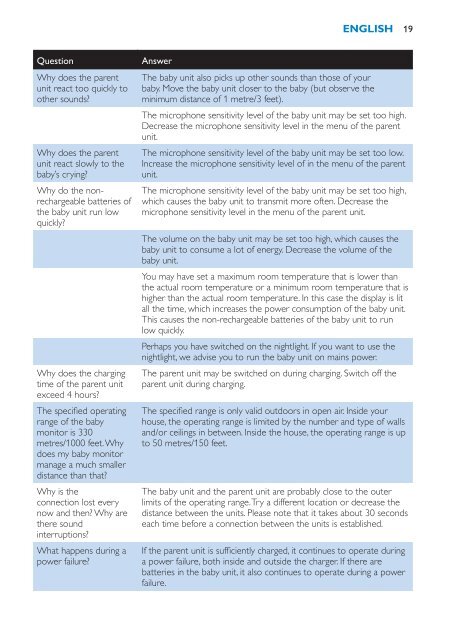Philips Avent DECT baby monitor - User manual - HUN
Philips Avent DECT baby monitor - User manual - HUN
Philips Avent DECT baby monitor - User manual - HUN
You also want an ePaper? Increase the reach of your titles
YUMPU automatically turns print PDFs into web optimized ePapers that Google loves.
English 19<br />
Question<br />
Why does the parent<br />
unit react too quickly to<br />
other sounds?<br />
Why does the parent<br />
unit react slowly to the<br />
<strong>baby</strong>’s crying?<br />
Why do the nonrechargeable<br />
batteries of<br />
the <strong>baby</strong> unit run low<br />
quickly?<br />
Why does the charging<br />
time of the parent unit<br />
exceed 4 hours?<br />
The specified operating<br />
range of the <strong>baby</strong><br />
<strong>monitor</strong> is 330<br />
metres/1000 feet. Why<br />
does my <strong>baby</strong> <strong>monitor</strong><br />
manage a much smaller<br />
distance than that?<br />
Why is the<br />
connection lost every<br />
now and then? Why are<br />
there sound<br />
interruptions?<br />
What happens during a<br />
power failure?<br />
Answer<br />
The <strong>baby</strong> unit also picks up other sounds than those of your<br />
<strong>baby</strong>. Move the <strong>baby</strong> unit closer to the <strong>baby</strong> (but observe the<br />
minimum distance of 1 metre/3 feet).<br />
The microphone sensitivity level of the <strong>baby</strong> unit may be set too high.<br />
Decrease the microphone sensitivity level in the menu of the parent<br />
unit.<br />
The microphone sensitivity level of the <strong>baby</strong> unit may be set too low.<br />
Increase the microphone sensitivity level of in the menu of the parent<br />
unit.<br />
The microphone sensitivity level of the <strong>baby</strong> unit may be set too high,<br />
which causes the <strong>baby</strong> unit to transmit more often. Decrease the<br />
microphone sensitivity level in the menu of the parent unit.<br />
The volume on the <strong>baby</strong> unit may be set too high, which causes the<br />
<strong>baby</strong> unit to consume a lot of energy. Decrease the volume of the<br />
<strong>baby</strong> unit.<br />
You may have set a maximum room temperature that is lower than<br />
the actual room temperature or a minimum room temperature that is<br />
higher than the actual room temperature. In this case the display is lit<br />
all the time, which increases the power consumption of the <strong>baby</strong> unit.<br />
This causes the non-rechargeable batteries of the <strong>baby</strong> unit to run<br />
low quickly.<br />
Perhaps you have switched on the nightlight. If you want to use the<br />
nightlight, we advise you to run the <strong>baby</strong> unit on mains power.<br />
The parent unit may be switched on during charging. Switch off the<br />
parent unit during charging.<br />
The specified range is only valid outdoors in open air. Inside your<br />
house, the operating range is limited by the number and type of walls<br />
and/or ceilings in between. Inside the house, the operating range is up<br />
to 50 metres/150 feet.<br />
The <strong>baby</strong> unit and the parent unit are probably close to the outer<br />
limits of the operating range. Try a different location or decrease the<br />
distance between the units. Please note that it takes about 30 seconds<br />
each time before a connection between the units is established.<br />
If the parent unit is sufficiently charged, it continues to operate during<br />
a power failure, both inside and outside the charger. If there are<br />
batteries in the <strong>baby</strong> unit, it also continues to operate during a power<br />
failure.
















